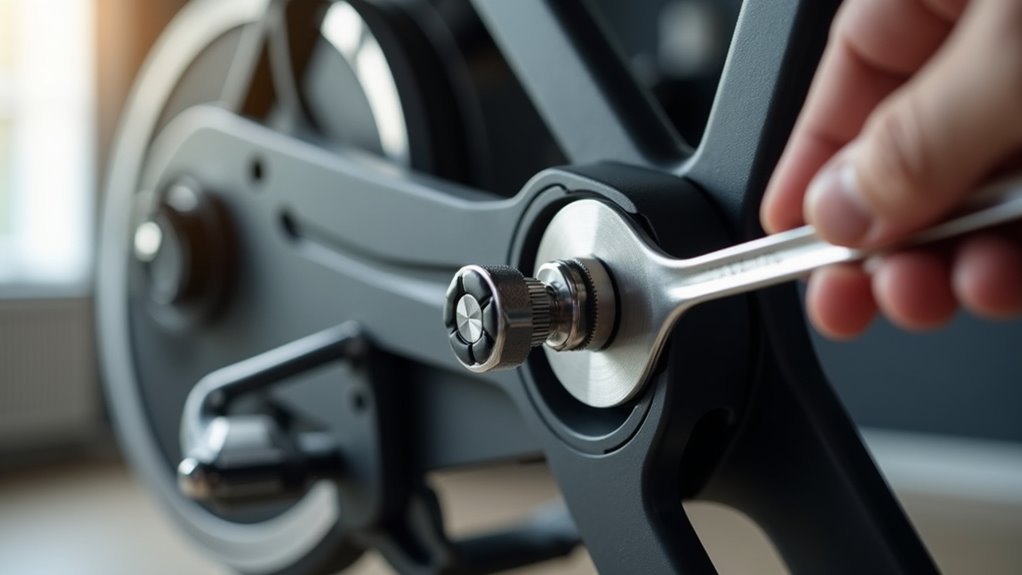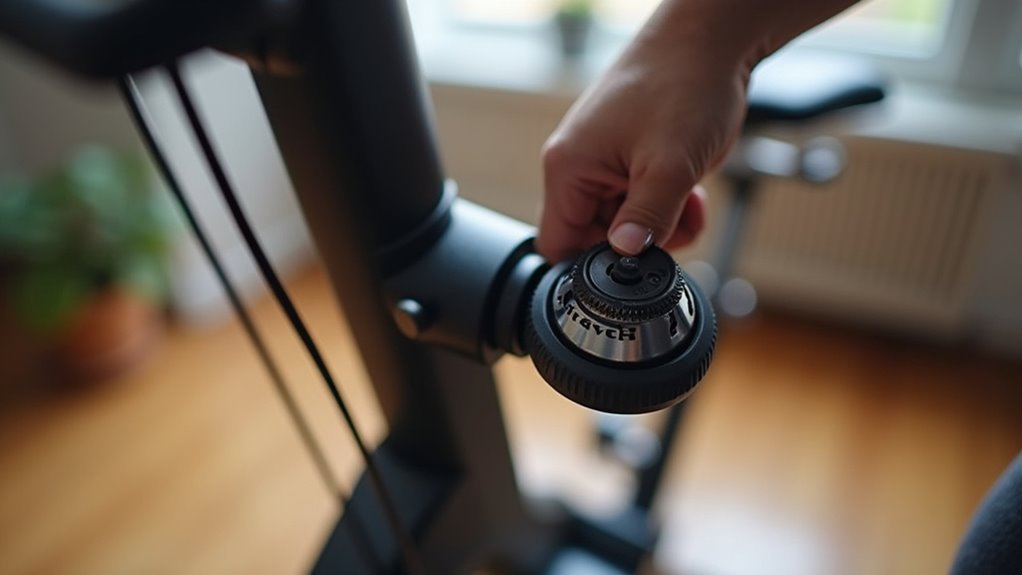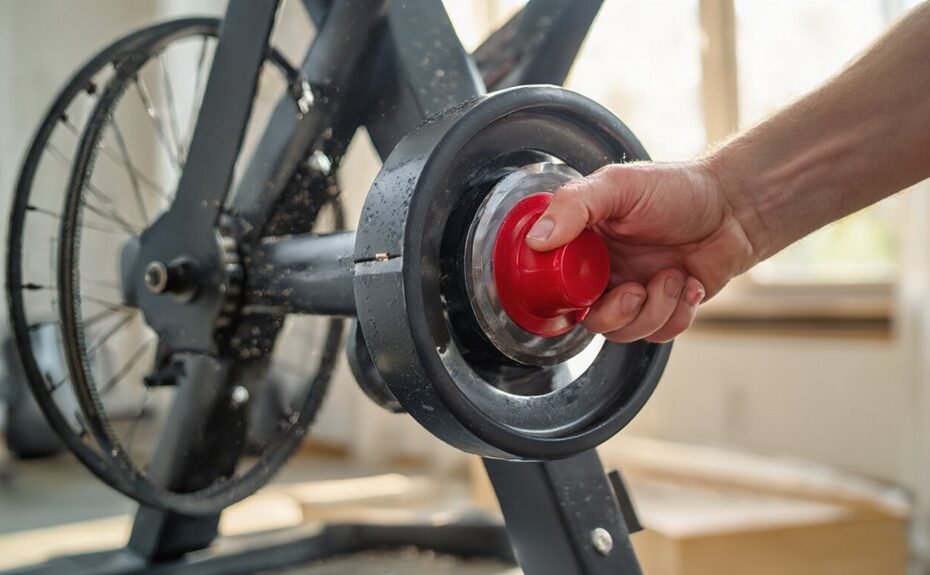Exercise bikes often develop resistance issues that can derail a workout routine. When riders hop on expecting a challenging session, they’re left frustrated by stuck settings or inconsistent tension. The problem might stem from worn brake pads, loose cables, or magnetic system failures. Most people don’t realize that even dust buildup in adjustment mechanisms can cause these headaches. Regular maintenance isn’t just recommended—it’s essential for keeping that resistance working properly. What’s happening inside the bike when these problems occur?
Common Resistance System Failures in Exercise Bikes
Common failures typically stem from wear and tear on brake pads, magnetic coils, or flywheels, leading to ineffective resistance changes. Slack tension cables or loose belts frequently cause jumpy resistance adjustments, while control system glitches in digital consoles can prevent proper settings changes. A buildup of dust in adjustment mechanisms is also problematic. Internal problems like a stretched resistance belt—often caused by moisture exposure—are harder to diagnose but frequently explain why your exercise bike suddenly feels too easy during workouts. Regular maintenance of the resistance mechanism can help prevent these issues from arising in the first place.
Understanding Magnetic Tension Mechanisms
Magnetic tension mechanisms represent the heart of modern exercise bike resistance systems, transforming workout experiences through their elegant engineering.
Unlike older friction-based models, these systems create resistance by adjusting the distance between magnets and the flywheel, allowing for smooth, nearly silent shifts between resistance levels.
When problems arise, they’re typically caused by misalignment, dust buildup, or issues with the control system’s wiring connections.
While they don’t suffer from brake pad wear and tear, magnetic tension mechanisms aren’t maintenance-free.
Regular checks of magnet alignment and electrical components guarantee peak performance. Most users don’t realize that even these sophisticated systems need occasional attention to maintain their functionality. Additionally, understanding the importance of regular checks can significantly enhance the longevity of your exercise bike.
Troubleshooting Your Bike’s Resistance Controls

Tackling resistance issues on your exercise bike requires a methodical approach to identify the root cause. When troubleshooting, examine the connections between the console and resistance unit for any wiring issues that might interrupt signals.
Test the tension motor with a 9-volt battery and check voltage supply from the console, which should be around 6 VDC. Look for mechanical jams or wear that might prevent smooth adjustment.
- Check for loose or damaged wiring connections first – they’re often the culprit
- Test the resistance motor directly to isolate electrical vs. mechanical problems
- Measure voltage output from the console to determine if it’s sending proper signals
- Don’t forget regular cleaning and maintenance can prevent most issues from developing.
- Understanding the type of resistance system your bike uses can also help you identify specific issues related to resistance adjustment.
Quick Fixes for Stuck Resistance Levels
Many exercise bike enthusiasts encounter moments when resistance levels become unresponsive or stuck at a particular setting. These frustrating situations often have simple solutions.
Start by cleaning dust buildup from resistance knobs and adjustment dials, which can prevent smooth operation. Then inspect the mechanism for debris that might be causing jams.
Don’t overlook loose connections – tighten any screws that might be creating slack in the system.
Check wiring connections between the console and resistance mechanism for damage. Sometimes, the easiest fix is to reset the system by unplugging the bike for a minute, which clears minor electronic glitches affecting how the resistance adjust.
When to Call a Professional Repair Service

While simple resistance issues often have DIY solutions, persistent electrical problems or major mechanical failures require expert attention.
Exercise bike consoles that consistently malfunction or motors that make unusual noises typically indicate deeper issues beyond basic troubleshooting capabilities.
In these situations, a professional repair service can provide thorough diagnostics and specialized repairs that will extend your equipment’s lifespan and maintain safe operation.
Persistent Electrical Problems
Electrical gremlins in your exercise bike can quickly turn your fitness routine into a frustrating experience. When persistent electrical problems occur, a professional diagnosis becomes essential.
Faulty wiring or a malfunctioning tension motor often prevents resistance adjustments and requires expert repair. If you’ve tried basic troubleshooting steps without success, it’s time to call in a specialist.
- Voltage readings below 6 VDC from console to motor suggest electrical failure
- Technicians can test motor functionality using a simple 9-volt battery
- Worn wiring connections between components cause intermittent resistance issues
- Professional thorough diagnostics can identify problems that DIY methods miss
Major Mechanical Failures
Several critical mechanical failures in exercise bikes demand immediate professional attention, as they extend beyond the scope of typical DIY repairs.
A malfunctioning tension motor often prevents resistance adjustments completely, requiring expert diagnosis.
When your bike’s resistance stays fixed despite console inputs, it’s likely due to internal wiring issues or a faulty motor driver.
Mechanical jams can also impede proper function, necessitating technician inspection with specialized tools.
While regular maintenance like lubrication helps prevent some problems, complex issues involving electronic components need professional expertise.
If you’ve tried basic troubleshooting and the resistance still won’t budge, it’s probably time to call for repair service.
Preventative Maintenance for Magnetic Resistance Systems
Preventative maintenance of magnetic resistance systems begins with regular cleaning and inspection of all components to prevent performance issues before they start.
Setting a monthly schedule for lubricating moving parts and checking tension cables guarantees your exercise bike maintains consistent resistance levels throughout its lifetime.
Proper calibration of the magnetic system, combined with firmware updates for smart bikes, greatly reduces the likelihood of major mechanical failures and extends the useful life of your equipment.
Cleaning Magnetic Components
Many exercise enthusiasts don’t realize that regular cleaning of magnetic components is the key to extending the life of their resistance systems. Dust and grime accumulation can seriously impact your bike’s functionality, making resistance adjustment knobs sticky or unresponsive.
Monthly maintenance should include thorough inspection for wear and corrosion, which, if left unchecked, can permanently damage magnetic resistance mechanisms.
- Use a soft, dry cloth to wipe down the flywheel—think of it as dusting off your bike’s brain
- Clean adjustment knobs regularly to maintain smooth resistance changes
- Inspect for corrosion signs monthly (rust is like cancer for magnetic components)
- Don’t forget to check hidden areas where performance-killing debris often accumulates
Regular Inspection Schedule
Consistently establishing a monthly inspection routine for your exercise bike’s resistance system will dramatically extend its lifespan and performance.
During these regular inspections, check resistance components for wear and tear, paying special attention to magnetic coils and tension cables that often loosen over time.
Clean adjustment mechanisms and document any functionality issues you discover. This maintenance schedule should include testing the security of wiring connections, which can affect resistance adjustments if compromised.
Like a car needs oil changes, your exercise bike needs these check-ups to prevent major breakdowns. Most performance problems can be caught early when you’re diligent about inspections—they’re really the frontline defense against resistance failures.
Calibration Prevents Failure
Regular calibration of magnetic resistance systems serves as the cornerstone of preventing exercise bike failures. Without proper maintenance, even high-quality equipment can develop slack tension cables or loose belts, leading to erratic resistance changes and a frustrating user experience.
Calibration guarantees the resistance levels remain consistent, which directly impacts workout effectiveness.
- Routine calibration identifies mechanical issues before they cause complete system failure
- Updated firmware on digital consoles synchronizes resistance adjustments with user input
- Cleaning and lubricating magnetic resistance components extends their operational lifespan
- Consistent resistance levels prevent workout plateaus and maintain training progress
Frequently Asked Questions
Why Is the Resistance on My Exercise Bike Not Working?
Silent pedals tell a story: resistance issues commonly stem from worn brake pads, slack tension cables, electronic components failure, or accumulated debris. Manual troubleshooting of specific resistance types varies across bike brands.
How to Adjust Resistance on Stationary Bike?
To adjust stationary bike resistance, rotate the resistance knob clockwise to increase difficulty or use digital controls on electric models. Proper bike setup guarantees effective cycling techniques and maximizes workout efficiency across various resistance levels.
How to Calibrate a Stationary Bike?
Proper stationary bike calibration involves placing it on level ground, accessing console settings, adjusting resistance mechanisms according to the user manual, checking connections, and testing resistance adjustments—essential for accurate performance tracking during indoor cycling sessions.
Is 30 Minutes of Stationary Bike the Same as 30 Minutes of Walking?
Time is gold when exercising. Thirty minutes on a stationary bike typically burns more calories than walking, with different muscle engagement differences, reduced joint impact, and comparable cardiovascular health benefits, depending on workout intensity levels.
